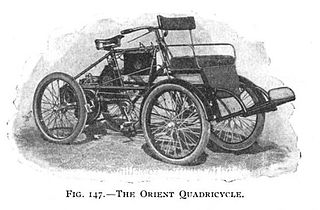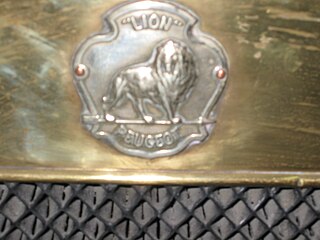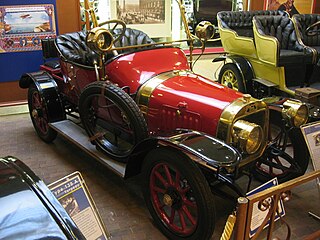History
In 1889 Peugeot attended that year's Paris Universal Exhibition, where he was demonstrating four of his Peugeot Type 1 prototypes, which were powered by steam engines (from Léon Serpollet). The Type 1 received a tepid reception, and Peugeot was already aware of the limitations arising from the vibration profile and sheer weight of a steam engine in this type of car-sized powered vehicle.
The visit to the exhibition was not wasted, however, as he also came across the revolutionary invention of Gottlieb Daimler, a reciprocating combustion engine powered by petrol/gasoline. As soon as the exhibition was over Daimler arranged for his engine to be assembled in France by Panhard et Levassor of Paris and came to an agreement with Peugeot for its use in a new quadricycle. Peugeot was also able to negotiate with the widow of Edouard Sarazin. Sarazin's acquisition, before he died, of the rights to manufacture the Daimler combustion engine in France, made his widow, Louise, a key figure in the early life of the motor industry in France, which would be the world's top auto producing nation till out-produced by the United States in 1906. [1]
Approximately a year after Armand Peugeot's eventful visit to Paris, the Peugeot Type 2 appeared, to be followed by the Type 3, which events together marked the inauguration of the Peugeot automobile business.
The Peugeot Type 2 was powered by a two-cylinder four stroke V-format petrol/gasoline engine, assembled under licence from Daimler. The engine was mounted underneath the seat, above and slightly ahead of the rear axle to which it was linked by a chain-drive. 2.0 PS (2 hp; 1.5 kW) of power was provided from the 565-cubic-centimetre (34.5 cu in) unit. A maximum speed of 18 km/h (11 mph) was recorded. Engine cooling in the 1880s was a challenge for the combustion engine. To solve this, the Type 2's engine incorporated tubes filled with water, adumbrating the radiator that would be an essential feature of many combustion engines in the ensuing centuries.
A wheelbase of 1,400 mm (55.1 in) supported a vehicle length of 2,300 mm (90.6 in). The width and height were respectively 1,350 mm (53.1 in) and 1,450 mm (57.1 in). A rudimentary suspension system pointed the way ahead regarding what would become another mainstream feature of the motor car.
The main Peugeot business was, at this time, expanding rapidly its bicycle production, and the Type 2’s light weight may have incorporated lessons learned from cycle production. Four Type 2s were produced. Three were quadricycles while the fourth was a tricycle. They all had space for two on the bench above the engine.

Peugeot is a French automobile brand owned by Stellantis.

Gottlieb Wilhelm Daimler was a German engineer, industrial designer and industrialist born in Schorndorf, in what is now Germany. He was a pioneer of internal-combustion engines and automobile development. He invented the high-speed liquid petroleum-fueled engine.

Panhard was a French motor vehicle manufacturer that began as one of the first makers of automobiles. It was a manufacturer of light tactical and military vehicles. Its final incarnation, now owned by Renault Trucks Defense, was formed by the acquisition of Panhard by Auverland in 2005, and then by Renault in 2012. In 2018 Renault Trucks Defense, ACMAT and Panhard combined under a single brand, Arquus.

The Quadricycle was an early form of automobile. Earliest models were propelled by a small steam engine, then designers switched to early internal combustion engines as they became available. The word is derived from the fact that it had four wheels and used a lot of technology from the bicycles of the era.

Armand Peugeot was a French industrialist, pioneer of the automobile industry and the man who transformed Peugeot into a manufacturer of bicycles and, later, of automobiles. He was accepted into the Automotive Hall of Fame in 1999.

A car, or an automobile, is a motor vehicle with wheels. Most definitions of cars state that they run primarily on roads, seat one to eight people, have four wheels, and mainly transport people over cargo. There are around one billion cars in use worldwide. The car is considered an essential part of the developed economy.

Émile Constant Levassor was a French engineer and a pioneer of the automobile industry and car racing in France.

Lion-Peugeot is a formerly independent French auto-maker. It is the name under which in 1906 Robert Peugeot and his two brothers, independently of the established Peugeot car business, began to produce automobiles at Beaulieu near Valentigney.
The Peugeot Type 14 is an early motor car produced between 1897 and 1898 by the French auto-maker Peugeot at their Audincourt plant. First presented in public at the end of 1896 the Type 14 was the first new car introduction after Armand Peugeot’s new company “Automobiles Peugeot” had been registered, following formalisation of Armand's split from the then principal Peugeot business.

The Lion-Peugeot Type VA is an early motor car produced near Valentigney by the French auto-maker Lion-Peugeot between 1907 and 1908.

The Lion-Peugeot Type VC2 was an early motor car produced near Valentigney by the French auto-maker Lion-Peugeot between 1909 and 1910. 1,175 were produced.
The Lion-Peugeot Type VY and the Lion-Peugeot Type VY2 were early motor cars produced near Valentigney by the French auto-maker Lion-Peugeot between 1908 and 1909.

The Lion-Peugeot Type V2C2 was early motor car produced near Valentigney by the French auto-maker Lion-Peugeot in 1910. By this time Lion-Peugeot had been producing motor cars for four years, but the V2C2 was the first model with an engine of more than one cylinder.
The Lion-Peugeot Type V2Y2 was an early motor car produced near Valentigney by the French auto-maker Lion-Peugeot in 1910. It closely resembled the manufacturer's Type V2C2, but it had a larger engine and was faster. 300 V2Y2s were produced.
The Lion-Peugeot Type V2Y3 was a motor car produced near Valentigney by the French auto-maker Lion-Peugeot in 1911. It closely resembled the manufacturer's Type V2C3, but it had a larger engine and was faster. 215 V2Y3s were produced.

The Lion-Peugeot Type V4C3 was a motor car produced near Valentigney by the French auto-maker Lion-Peugeot between 1912 and 1913. It was the manufacturer's first car with a four-cylinder engine. 653 were produced.
The Lion-Peugeot Type VD2 was a motor car produced near Valentigney by the French auto-maker Lion-Peugeot in 1915. It was usefully longer than the manufacturer's 1914 model, the Type V4D Approximately 480 Lion-Peugeot Type VD2s were produced. It was the last Lion-Peugeot produced before wartime economic conditions enforced the closure of Lion-Peugeot automobile production. Subsequent small Peugeots would be badged simply as Peugeots and produced in plants that had developed during the period, before 1910, when "Automobiles Peugeot" was a separate business.
France was a pioneer in the automotive industry and is the 11th-largest automobile manufacturer in the world by 2015 unit production and the third-largest in Europe. It had consistently been the 4th-largest from the end of World War II up to 2000. It is 16% of sales of French manufactured products.
The Paris–Marseille–Paris race was the first competitive 'city to city' motor race originating in Paris, where the first car across the line was the winner, prior events having selected the winner by various forms of classification and judging. The race was won by Émile Mayade who completed the ten-day, 1,710 km, event over unsurfaced roads in 67 hours driving a Panhard et Levassor.
This page is based on this
Wikipedia article Text is available under the
CC BY-SA 4.0 license; additional terms may apply.
Images, videos and audio are available under their respective licenses.











